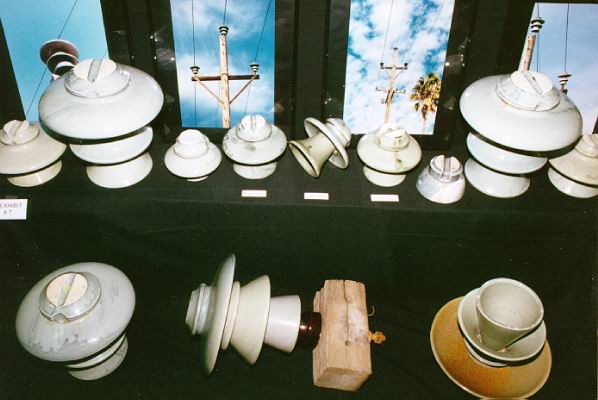Old Gray Multiparts
Circa 1904 to 1915
[Page 1]
Page 2 Locke-Victor
Page 3 Thomas
Page 4 Ohio Brass
Page 5 Insulators in service
Little has been written about the old gray multipart porcelain insulators. Very few have survived. Most collectors are not familiar with the gray multis since so few have been found and the active multi collectors gobble them up as fast as they become available. Once you see the variety and beauty of these early insulators you will surely gain an appreciation for them.
I first saw a gray multipart insulator at the St. Charles National in 1985. It was an M-4395 with a huge cross-top crown and a large embossed Ohio Brass logo on the crown. No one at that time knew what it was or even how old it could have been. Chris Hedges was the only person interested enough to purchased the insulator and he had Wes and Clarice Gordon transport it back to Kansas City on their way back to home to southern California. It wasn't until about two years later that I found out some history on that type of insulator which I mistakenly thought was the M-4338 that was used 1909 on the Niagara, Lockport and Ontario Power Co. line to replace lightning-damaged M-3890's. The details of this line, the insulators used, and the interesting story about the lightning problems, can be found in my new book, Multipart Porcelain Insulators: 2nd Edition. In the mid-1990's, Ken Willick found a few M-4338's for the first time which confirmed this was the style (not M-4395) that was used on the line. The M-4338's are smaller and have the incuse marking, VICTOR. They are maybe twice as rare as M-4395. There are a few M-4395's still in service in New York at a railroad crossing. They are stacked on top of each other with a special iron bracket that fits on the heavy crown.
Ohio Brass M-4395 (left) and Victor M-4338 (right) in Jeff Kaminski's collection. M-4395 has a flat gray colored glaze with some mottling. M-4338 has a greenish-gray glaze with some nice mottling. M-4338 has a fourth skirt recessed inside the bottom skirt to provide a dry leakage path. This was the first insulator designed to not be taller than the width of the top skirt in an effort to reduce damage from lightning strikes. Both insulators have a cross-top conductor groove.
The gray glaze was used by only three companies: Thomas, Locke (Victor markings), and Ohio Brass. The glazes are rather distinctive on each. The Ohio Brass gray glaze is a flat gray with no hint of green or blue. The glaze is often mottled or drippy from white-gray to dark gray. The gray glaze on Thomas insulators is typically a greenish-gray often mottled with darker green bands and drips. However, the glaze on M-2340's (perhaps the earliest Thomas gray) looks more like the Ohio Brass gray glaze with only a vague hint of green. The greenish-gray Thomas glazes can be very pretty leading some people to call them "green". Sometimes the mottling goes into a pale tan where the glaze is extremely thin. The Locke (with VICTOR markings) gray glaze can be a light greenish-gray or bluish-gray. Often the bluish-gray Locke glaze will have millions of dark blue specs. The Locke gray glazes are often mottled, too, and sometimes have drips of darker glaze. Some glazes are a smooth bluish-gray with no blue specs, which looks like bluish cream. There are a few Victor multis that have light sprays of tan or light brown glaze that is apparently and overspray from a nearby glazing operation. This is usually underneath the top skirt. What makes some gray multis even more attractive are the combinations of shells with much different glaze colors. The manufacturers obviously had difficulty making a uniform glaze prior to 1920 and the gray glaze is no exception.
There are 19 known styles of gray multis: seven 2-part, six 3-part, and six 4-part. A gray glaze was used because it was believed that the insulators would blend in better with the color of the sky. The gray glaze was used from about 1904 to about 1915. Some gray Victor replacements may have been used in the northwest as late as 1919 as indicated by marking types. Rather than repeat historical information that is in my book, I'll just present a number of photographs of various gray multis with notes on each. Bill Rohde has the most variety of gray multis so let's start with a few photos of a display he had a few years ago.

Note the brown glaze sprayed under the top skirt on the insulator at bottom right.
Go to: Page 2